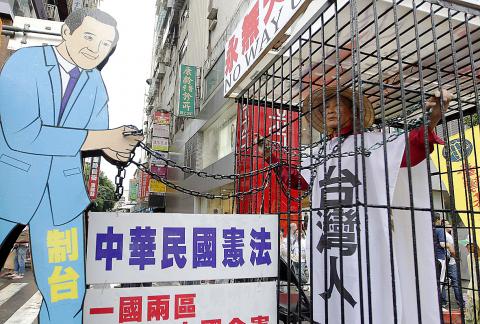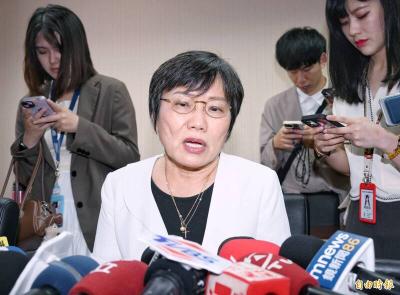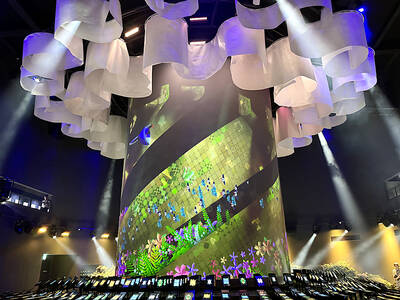People from all walks of life took to the streets in Taipei yesterday to voice their dissatisfaction with President Ma Ying-jeou’s (馬英九) governance.
A group of Hakka people held big black flags with calligraphy in white that read yimin (義民, “righteous people”) as they marched. The flag is modeled on the black flags used by Hakka militias who defended their home villages during an uprising against the Qing Dynasty in 1786 and again when they fought against the Japanese occupation of Taiwan in 1895.
“The flag symbolizes the Hakka resistance against injustice and the Hakka spirit of defending our homeland,” said Lee Ting-kun (李廷坤), from Taoyuan County. “We’re here today to tell Ma that most people are suffering in this country. We want to survive and live happily. Isn’t this what the government is supposed to do for us?”

Photo: Lo Pei-der, Taipei Times
Another group, from Greater Taichung, that stood out staged a mock funeral procession.
Two men were dressed up as Taoist priests and performed funeral rites as they marched, followed by people carrying big black-and-white portraits of Ma and Premier Sean Chen (陳?) and an ancestral tablet for the deceased with Ma’s name written on it.
“Doomed by the public, died without disease,” one placard read.

Photo: Fang Pin-chao,Taipei Times
“Skyrocketing utility prices have aroused the anger of gods and men alike,” another placard read.
A 66-year-old woman, Lee Chuang (李妝), wore a pair of hand-woven traditional shoulder pads connected to a “halo” behind her head, and held a hand-woven flag that read: “Step down.”
“This is the outfit of the goddess of mercy,” Lee told the Taipei Times. “My son had a dream a few days ago in which the goddess of mercy told him that Ma should step down to end people’s suffering, so he hand-made this outfit for me to wear in the parade.”

Photo: Reuters / Pichi Chuang
Besides being worried about rising utility prices, Lee said she was also worried that a rising national debt would increase the suffering of the next generation.
“As a mother, I’m really concerned that my children and my grandchildren will have to carry the debts that Ma leaves them,” she said.
Many people who supported Ma during the presidential election also took part in the demonstration.
“I regret voting for Ma. I regret it a lot,” one man said. “Ma had a different attitude before his election. He acted as if he cared about the people before the election, but now he doesn’t listen to what people want.”
The People First Party, normally seen as an ally of the Chinese Nationalist Party (KMT), said on Friday it encouraged its members to take part in the Democratic Progressive Party-sponsored protest on their own accord.
PFP spokesman Wu Kun-yu (吳崑玉) and PFP Taipei City Councilor Lin Kuo-cheng (林國成) were spotted in the rally yesterday, chanting slogans calling on Ma to step down.
“Ma should pay more attention to what people want; otherwise he is not suitable to be the president,” Lin said.
Chen Che (陳哲), the host of the Facebook group “Let’s Meet Up on May 20” (520我們不見不散), held up a sign that said: “Net friends, let’s meet up here,” .
“The Facebook group was created on March 18, because I think that, with so many Internet users complaining about Ma, we should do more than criticize him and his policies on the Internet. We should turn our dissatisfaction into action,” he said, adding that two months after the online group was created, it has attracted nearly 3,000 members.
Chang Chia-ling (張嘉玲), director of the DPP’s Department of Women’s Development, also caught many people’s eye when she joined the rally at one of the assembly points, outside National Taiwan University campus, in her bright red wedding gown.
“I came directly from my wedding banquet,” she said. “I will remember this day for all my life, not only because it’s my wedding day, but also because this is the day when so many Taiwanese people have come out to tell the government that we’re suffering.”

Chinese Nationalist Party (KMT) Chairman Eric Chu (朱立倫), spokeswoman Yang Chih-yu (楊智伃) and Legislator Hsieh Lung-chieh (謝龍介) would be summoned by police for questioning for leading an illegal assembly on Thursday evening last week, Minister of the Interior Liu Shyh-fang (劉世芳) said today. The three KMT officials led an assembly outside the Taipei City Prosecutors’ Office, a restricted area where public assembly is not allowed, protesting the questioning of several KMT staff and searches of KMT headquarters and offices in a recall petition forgery case. Chu, Yang and Hsieh are all suspected of contravening the Assembly and Parade Act (集會遊行法) by holding

PRAISE: Japanese visitor Takashi Kubota said the Taiwanese temple architecture images showcased in the AI Art Gallery were the most impressive displays he saw Taiwan does not have an official pavilion at the World Expo in Osaka, Japan, because of its diplomatic predicament, but the government-backed Tech World pavilion is drawing interest with its unique recreations of works by Taiwanese artists. The pavilion features an artificial intelligence (AI)-based art gallery showcasing works of famous Taiwanese artists from the Japanese colonial period using innovative technologies. Among its main simulated displays are Eastern gouache paintings by Chen Chin (陳進), Lin Yu-shan (林玉山) and Kuo Hsueh-hu (郭雪湖), who were the three young Taiwanese painters selected for the East Asian Painting exhibition in 1927. Gouache is a water-based

Taiwan would welcome the return of Honduras as a diplomatic ally if its next president decides to make such a move, Minister of Foreign Affairs Lin Chia-lung (林佳龍) said yesterday. “Of course, we would welcome Honduras if they want to restore diplomatic ties with Taiwan after their elections,” Lin said at a meeting of the legislature’s Foreign Affairs and National Defense Committee, when asked to comment on statements made by two of the three Honduran presidential candidates during the presidential campaign in the Central American country. Taiwan is paying close attention to the region as a whole in the wake of a

OFF-TARGET: More than 30,000 participants were expected to take part in the Games next month, but only 6,550 foreign and 19,400 Taiwanese athletes have registered Taipei city councilors yesterday blasted the organizers of next month’s World Masters Games over sudden timetable and venue changes, which they said have caused thousands of participants to back out of the international sporting event, among other organizational issues. They also cited visa delays and political interference by China as reasons many foreign athletes are requesting refunds for the event, to be held from May 17 to 30. Jointly organized by the Taipei and New Taipei City governments, the games have been rocked by numerous controversies since preparations began in 2020. Taipei City Councilor Lin Yen-feng (林延鳳) said yesterday that new measures by